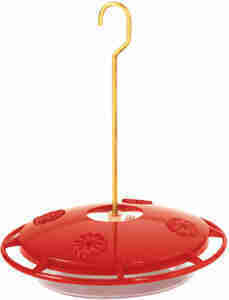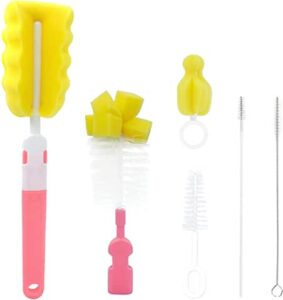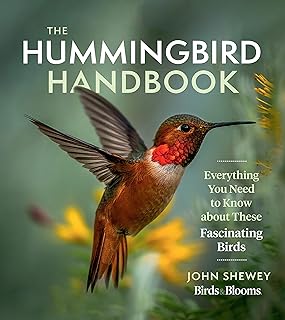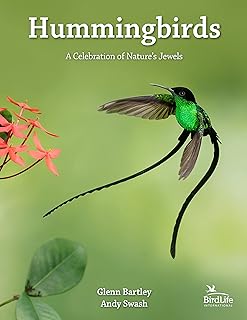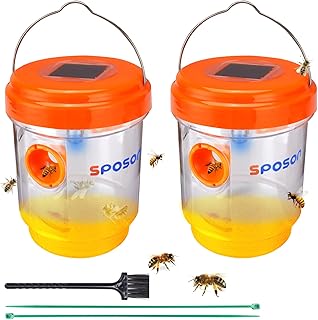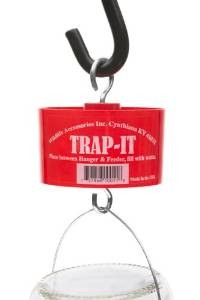Looking to bee proof your existing hummingbird feeder or wanting to buy a bee proof hummingbird feeder?
Here you will learn how to ant and and bee proof your hummingbird feeder, how to make hummingbird food, how to clean your feeder and at the end of this article is my special free video course video on how to quickly be able to hand-feed your hummingbirds.
Feeding hummingbirds with a feeder is a great way to view hummingbirds up close. It’s a lot of fun and very exciting to see and hear them buzzing around a feeder. Bees, wasps and other flying insects can also be seen buzzing around a feeder. That’s not quite so exciting! But luckily, there are easy ways to prevent bees, wasps and flying insects from ruining your hummingbird feeding enjoyment!
A hummingbird feeder filled with sweet nectar is sooner or later, going to attract bees, wasps and other flying insects to the feeder. Bees, like hummingbirds, enjoy the taste of sweet nectar. Fortunately for hummingbird lovers, there are hummingbird feeders that come equipped with built-in barriers that keep bees form reaching the hummingbird food. Since the bees and other insects can’t reach the nectar, after a while the bees will give up and move on.
The HummZinger Ultra hummingbird feeder has patented “Nectar-Guard” tips on the feeding ports of the feeder. These plastic tips keep bees, wasps and other flying insects from feeding at the feeder ports. The bees and wasps won’t be able to access the nectar and contaminate your hummingbird food.
These plastic Nectar Guard tips slide into the feeding ports on the underside of the hummingbird feeder cover. Each tip has a flexible membrane in the center which easily opens up when a hummingbird inserts it’s beak into the feeding port to feed. When the hummingbird withdraws it’s beak the the membrane closes tight to keep bees and wasps out of your feeder.
The HummZinger Ultra … the best bee proof hummingbird feeder!
The HummZinger Ultra is an inexpensive hummingbird feeder that holds 12 ounces of hummingbird food. The feeder has 4 feeding ports and is easy to clean and easy to fill. It’s easy to clean because it comes apart in the middle and gives you complete access to the inside. An easier to clean feeder is a great asset and makes it so much easier to keep your feeder clean.There are no hidden surfaces inside the feeder that are hard to reach or hard to clean.
A clean feeder is very important if you want to be successful at attracting hummingbirds. They won’t come to a dirty feeder and a clean feeder is essential to the health of the hummingbirds. An easy to clean feeder makes it more probable that you will do the necessary maintenance to insure that you have hummingbirds returning to your feeder to feed quite often.
The saucer type design of this feeder makes it a drip proof feeder. Inverted bottle type feeders will develop an air space at the top of the feeder as the volume of nectar goes down. When this air space is heated it will expand and force nectar out of the feeder ports. This dripping nectar will attract ants, bees, wasps and other unwanted guests to the feeder. Because it is drip proof, this hummingbird feeder won’t attract anything but hummingbirds. Another great feature of the HummZinger Ultra feeder is that the feeder has a built in ant moat. The ant moat is a basin around the feeder hanger that you can fill with water. Because ants can’t swim, the ants won’t be able to reach the humming food inside the feeder.
This feeder can be hung or mounted on a pole. All these great features combined with the inexpensive price make it one of the best feeders money can buy. Bee proof, ant proof, leak proof, easy to clean and guaranteed for life. What more could you want from a hummingbird feeder?! Click here if you want to buy a great bee proof and ant proof hummingbird feeder!
If you already have a feeder that you want to bee proof, here is a video that shows how one guy used plastic mesh from an onion sack to cover the feeding ports of the feeder. The feeder ports were too large and allowed honey bees and yellow jackets easy access to the nectar. He glued the plastic mesh inside the feeder and made the holes too small for bees and wasps, but the nectar ports still allowed hummingbirds to feed without any problems. It’s a good way to have a bee proof hummingbird feeder without having to buy a new feeder.
How to bee proof a hummingbird feeder video
How to keep ants away from a hummingbird feeder
Now that your feeder is bee and wasp proof you might want to go ahead and ant proof your hummingbird feeder too. The best way to ant proof your feeder is to use an ant moat or ant barrier as the are also called. You can either buy an ant moat or make your own. If you’re looking to buy a moat here is a good choice.
You simply hang the ant moat from a branch or feeder hook and hang your hummingbird feeder on the hook beneath the moat. Fill the ant moat with water and you will have a barrier that keeps ants away from your hummingbird food. The ant moat is red so it will help attract hummingbirds to your feeder too.
- Dimensions: 3 Dia. x 3.75 H.
Click here to see a wide selection of ant moats that are available for your hummingbird feeder. Ant moats are a great investment and will save you lots of aggravation and save you lots of nectar and time!
If you would like to try and make your own ant moat, here is a video to show you how.
When to change the hummingbird nectar
Along with bee proofing and ant proofing your hummingbird feeder, you should also know how to maintain it. This includes knowing when to change the nectar so it is always fresh and also how to clean your feeder each time the nectar is changed. Hummingbirds won’t feed at a feeder that’s dirty and contains spoiled nectar.
Cleaning your feeder will be a lot easier if you change the nectar before it becomes moldy and before mold grows on your feeder. Eventually the sugar in your hummingbird nectar will ferment and if allowed to remain in your feeder, it will eventually become moldy. The temperature of the outside air will determine how long your nectar will stay fresh before it needs to be changed. As a general rule, if the temperature stays below 70 degrees the nectar will need to be changed every week. Once the temp climbs above 70, it will need to be changed more often. Below is a chart that will help you determine how often to change the nectar so it doesn’t become moldy and make feeder cleaning a lot tougher. Also, another good indication is when the nectar becomes cloudy or has black spots growing in it, it needs to be changed more often.
High temperatures…………Change nectar after
71-75……………………………6 days
76-80……………………………5 days
81-84……………………………4 days
85-88……………………………3 days
89-92……………………………2 days
93+………………………………change every day
Cleaning a hummingbird feeder
The bleach solution used to kill mold is 1 cup of bleach to 1 gallon of water
If the nectar becomes cloudy and has black spots of mold in it, you need to change it more often. Once mold has contaminated your feeder, it will have to be sterilized using a mild bleach solution. Mix into 1 gallon of water 1/4 cup of bleach. Soak your feeder in the mild bleach solution for at least an hour. Use some type of bottle brush to thoroughly scrub your feeder, inside and out to remove all traces of mold. Once scrubbed, thoroughly rinse your feeder with running water, several times too remove all traces of bleach so it doesn’t harm the hummingbirds.
A clean hummingbird feeder is essential to keep the birds using your feeder on a regular basis. So, use this bleach solution once a month to help keep your feeder clean and use it anytime your nectar gets moldy. Hopefully, using the chart above will prevent your feeder from becoming contaminated with mold.
Below is a set of hummingbird feeder brushes that will be extremely helpful in cleaning your hummingbird feeder.
These feeder cleaning brushes used in combination with the Hummzinger feeder above, will keep your cleaning chore to a minimum and insure your success at attracting hummingbirds to your feeder.
Hummingbird nectar recipe
1 part sugar to 4 parts water
The only thing left that you need to know is how to make your own hummingbird food. You can make your own hummingbird food and save money as well as trips to the store. The nectar you make yourself, will also be healthier for your hummingbirds because it won’t contain any red food coloring. Red food coloring is not necessary to attract hummingbirds, which is the only reason it’s added in the first place. But more IMPORTANT, red food coloring is thought to be HARMFUL to hummingbirds. So, DONT use it.
Making your own hummingbird food is a simple process. The only 2 ingredients you need are tap water and regular white granulated table sugar. Don’t use any other sweeteners or ingredients such as brown sugar, karo syrup, maple syrup, Jello, Splenda, Sweet’N’Low or Equal. These ingredients don’t have the same chemical make-up as table sugar and can cause illness or even death to hummingbirds. White granulated table sugar and water will make the same sweet nectar that is found in the flowers that hummingbirds feed on.
Here is the Nectar Food Recipe
The nectar food recipe uses a 4 to 1 ratio of water to sugar. For example, 4 cups of water to 1 cup of sugar, 2 cups of water to 1/2 cup of sugar or 1 cup of water to 1/4 cup of sugar. Any of these ratios will make a nectar that is similar to the nectar found in flower blooms that hummingbirds feed on. The only difference is the volume of nectar that you will end up with. If you have nectar left over you can store it in the refrigerator for a week or so and use it as necessary.
First, into a pan on the stove, pour your water, then add the sugar and stir to dissolve the sugar while the mixture comes to a boil. Let the nectar boil for 2 minutes and remove from the heat to cool. When the nectar has cooled you can add it to your feeder. It’s that simple!
Why you might want to boil the water
Boiling the water will release the chlorine from the water and kill any mold or yeast spores that might be in the sugar, which would cause your hummingbird nectar to ferment quicker and have to be changed more often. Don’t boil the nectar for more than 2 minutes. Boiling any longer will boil away too much water and change the ratio of water to sugar. That would result in a sweeter nectar that would be more attractive to bees and wasps.
Now you know how to make your own hummingbird food, how to ant and bee proof your hummingbird feeder and how to maintain the feeder so the nectar is always fresh. You shouldn’t have any trouble attracting hummingbirds and keeping them coming to your feeder!
How to hand-feed hummingbirds instructional video
Here is my video that will teach you how to hand-feed your hummingbirds
Here is another technique you can use to hand-feed hummingbirds through a window in your home.
If you would like to watch my other free videos on hand-feeding different backyard birds and squirrels, click the link Hand-feeding backyard birds and squirrels
If you found this article helpful please share it using the social bookmarking buttons on the left side of this page. Help everyone to increase their enjoyment of hummingbirds.
Related searches:
Smithsonian Migratory Bird Center –hummingbird article
wikipedia –hummingbird article
